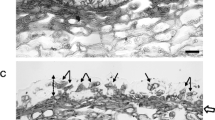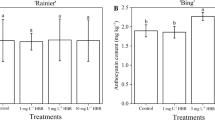Abstract
Fruit size has special importance for small-fruited early maturing cherry cultivars. In this study the effects of pre-harvest benzyladenine (BA) and BA plus gibberellin (GA) applications on fruit size and quality of ‘Noir de Guben’ sweet cherry (Prunus avium) were evaluated. ‘Noir de Guben’ trees were sprayed to run off with BA (50, 100 and 150 ppm) and BA + GA4+7 (12.5, 25, and 50 ppm) at straw-yellow color stage of the fruit. Fruit treated with BA (50, 100 and 150 ppm) and BA + GA4+7 (25 and 50 ppm) were significantly heavier and larger than the control. BA and BA + GA4+7 applications did not affect fruit firmness and fruit pH. 50 ppm BA-treated fruit had higher SSC (Soluble Solid Content) than control fruit. Excluding 25 ppm BA treatments, all treated fruit had higher acidity than the control fruit. BA and BA + GA4+7 applications delayed skin color development of the treated fruit. ‘Noir de Guben’ trees treated with the optimum concentrations of BA (150 ppm) and BA + GA4+7 (50 ppm) yielded fruit with 16.84 and 10.6 % greater weight, respectively.
Zusammenfassung
Der Fruchtgröße kommt bei kleinfrüchtigen, frühreifenden Süßkirschensorten eine besondere Bedeutung zu. Die Auswirkungen von Vorerntebehandlungen mit Benzyladenin (BA) sowie Benzyladenin plus Gibberelline (GA) auf die Fruchtgröße und Qualität der Süßkirschensorte ‘Noir de Guben’ wurden in dieser Studie untersucht. Die Bäume der Sorte ‘Noir de Guben’ wurden mit BA (50, 100 und 150 ppm) und BA + GA4+7 (12,5, 25 und 50 ppm) im hellgelben Farbstadium der Früchte tropfnass gespritzt. Die Früchte, die mit BA (50, 100 und 150 ppm) und BA + GA4+7 (25 und 50 ppm) behandelt wurden, waren schwerer und größer als die Früchte der Kontrolle. Die BA und BA + GA4+7 Behandlungen beeinflussten die Fruchtfleischfestigkeit und den pH-Wert des Fruchtsaftes nicht. Die mit 50 ppm BA behandelten Früchte hatten einen höheren Gehalt an löslicher Trockensubstanz als die Kontrollfrüchte. Die BA und BA + GA4+7 Behandlungen verzögerten die Fruchtausfärbung. Von den Bäumen, die mit der höchsten Konzentration von BA (150 ppm) und BA + GA4+7 (50 ppm) behandelt worden waren, konnten Früchte mit jeweils 16,84 bzw. 10,6 % höherem Gewicht geerntet werden.
Similar content being viewed by others
References
Canli FA, Orhan H (2009) Effects of pre-harvest gibberellic acid applications on fruit quality of ‘0900 Ziraat’ sweet cherry. HortTechnology 19:127–129
Canli FA, Pektas M, Calhan O, Kelen M (2009) Storage quality of ‘B.P. Morettini’ pear (Pyrus communis L.) fruits following pre-harvest bio-regulator applications. Int J Nat Eng Sci 3:1–5
Choi C, Wiersma PA, Toivonen P, Kappel F (2002) Fruit growth, firmness and cell wall hydrolytic enzyme activity during development of sweet cherry fruit treated with gibberellic acid (GA3). J Hortic Sci Biotech 77:615–621
Clayton M, Biasi WV, Agar IT, Southwick SM, Mitcham EJ (2006) Sensory quality of ‘Bing’ sweet cherries following preharvest treatment with hydrogen cyanamide, calcium ammonium nitrate, or gibberellic acid. HortScience 41:745–748
Einhorn TC, Wang Y, Turner J (2013) Sweet cherry fruit firmness and postharvest quality of late-maturing cultivars are improved with low-rate, single applications of gibberellic acid. HortScience 48:1010–1017
Facteau TJ, Rowe KE, Chestnut NE (1985) Response patterns of gibberellic acid-treated sweet cherry fruit at different soluble solids levels and leaf/fruit ratios. Sci Hortic 27:257–262
Horvitz S, Godoy C, López Camelo AF, Yommi A, Godoy C (2003) Application of gibberellic acid to ‘Sweetheart’ sweet cherries: effects on fruit quality at harvest and during cold storage. Acta Hort 628:311–316
Kappel F, MacDonald RA (2002) Gibberellic acid increases fruit firmness, fruit size, and delays maturity of ‘Sweetheart’ sweet cherry. J Am Pomol Soc 56:219–222
Koc A, Bilgener S (2013) Morphological characterization of cherry rootstock candidates selected from Samsun Province in Turkey. Turk J Agric For 37:575–584.
Lenehan OM, Whiting MD, Elfving DC (2006) Gibberellic acid inhibits floral bud development and improves ‘Bing’ sweet cherry fruit quality. HortScience 41:654–659
Looney NE (1996) Principles and practice of plant bio regulator usage in cherry production. In: Webster AD, Looney NE (eds) Cherries: crop physiology, production and users. CAB International, Wallingford pp. 279–298
Ozga J, Reinecke MD (2003) Hormonal interactions in fruit development. J Plant Growth Reg 22:73–81
Ozkaya O, Dundar O, Kuden A (2006) Effect of preharvest gibberellic acid treatments on postharvest quality of sweet cherry. J Food Agric Environ 4:189–191
Sabir E (1995) ‘Salihli’ ve ‘Noble’ Kiraz çeşitlerinde hasat öncesi GA3 uygulamalarinin depolama ve meyve kalitesine etkileri üzerine araştirmalar. Ege Üniversitesi, Fen Bilimleri Enstitüsü. Izmir, Turkey
Sarropoulou V, Dimassi-Theriou K, Therios I (2013) In vitro rooting and biochemical parameters in the cherry rootstocks CAB-6P and Gisela 6 using L-methionine. Turk J Agric For 37:688–698.
Serrano M, Guillen F, Martinez-Romero D, Castillo S, Valero D (2005) Chemical constituents and antioxidant activity of sweet cherry at different ripening stages. J Agric Food Chem 53:2741–2745.
Shargal A, Golobovich S, Yablovich Z, Shilizerman LA, Stern RA, Grafi G, Lev-Yadun S, Flaishman MA (2006) Synthetic cytokinin extend phase of division of paranchyma cells indeveloping pear (Pyrus communis L.) pears. J Hortic Sci Biotech 81:915–920
Stern RA, Flaishman M, Applebaum S, Ben-Arie R (2007) Effect of synthetic auxins on fruit development of Bing cherry (Prunus avium L.). Sci Hortic 114:275–280.
Usenik V, Kastelec D, Stampar F (2005) Physicochemical changes of sweet cherry fruits related to application of gibberellic acid. Food Chem 90:663–671
Webster AD, Spencer JE, Dover C, Atkinson CJ (2006) The Influence of sprays of gibberellic acid (GA3) and aminoethoxyvinylglycine (AVG) on fruit abscission, fruit ripening and quality of two sweet cherry cultivars. Acta Hort 727:467–472
Whiting MD, Ophardt D (2005) Comparing novel sweet cherry crop load management strategies. HortScience 40:1271–1275
Acknowledgements
We thank Egirdir Horticultural Research Station, Isparta, Turkey for opening up their orchard and facilities to conduct this research.
Author information
Authors and Affiliations
Corresponding author
Rights and permissions
About this article
Cite this article
Canli, F., Pektas, M. & Ercisli, S. Benzyladenine and Gibberellin Applications Improve Fruit Weight and Delay Maturity of Sweet Cherry. Erwerbs-Obstbau 57, 71–75 (2015). https://doi.org/10.1007/s10341-015-0231-0
Received:
Accepted:
Published:
Issue Date:
DOI: https://doi.org/10.1007/s10341-015-0231-0




